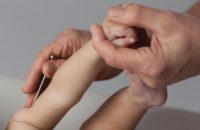Shonishin – Holistic Treatment for Infants and Children
by Heidi Yuen, Registered Acupuncturist and Certified Shonishin practitioner
 Shonishin (from Japanese shoni = little child, shin = needling) is a non-invasive method of acupuncture, which was developed in Japan for paediatric treatment around 100 years ago. Instead of traditional acupuncture needles, a special tool is used for rubbing and tapping on certain reflex zones and meridian areas, as well as on acupuncture points for gentle stimulation along the torso and the extremities.1
Shonishin (from Japanese shoni = little child, shin = needling) is a non-invasive method of acupuncture, which was developed in Japan for paediatric treatment around 100 years ago. Instead of traditional acupuncture needles, a special tool is used for rubbing and tapping on certain reflex zones and meridian areas, as well as on acupuncture points for gentle stimulation along the torso and the extremities.1
The therapeutic effect of Shonishin is to regulate and support the meridian system as well as the central and autonomic nervous systems. This treatment method is very effective, especially for children with different disharmonies or illnesses from birth to school age.
Time plays an important role when treating children, as they respond to treatment faster at a younger age. In some circumstances, holistic therapeutic intervention is necessary when a child does not respond well to modern Western medicine, it important to act promptly to avoid letting an opportunity pass. Timely intervention is vital, in the case of disorders and abnormalities, which can save much pain and suffering later in life.
Shonishin is a child-friendly therapy and children love the gentle touch. It is not a treatment for adults that has been altered for children; on the contrary, it was developed in response to the needs of children.
The theoretical foundation for Shonishin is a model of energetic development. This model brings the knowledge of modern neuroscience, developmental psychology and developmental physiology into harmony with the knowledge and experience of Oriental medicine. The motor, sensory and energetic functioning of the body is interwoven in this model. Meridians represent a communications network connecting a child with its external world. They are also responsible for the child’s development of posture, movement, patterns of behaviour and personality.
Shonishin is gaining popularity around the world. Apart from augmenting and preserving the children’s health, it is used to treat a wide variety of disorders, including2:
- Failure to thrive (FTT)
- Weak constitution
- Colic, excessive night crying, temper tantrums
- Indigestion, gastroesophageal reflux disease (GERD), constipation, and diarrhoea
- Night terrors
- Attention deficit hyperactivity disorder (ADHD)
- Allergies, asthma, and colds
- Eczema and hives
- Bedwetting
- Stuttering
- Spina bifida
- KISS syndrome3 (Kinematic Imbalance due to Suboccipital Strain)
The frequency, dosage and strength of Shonishin treatment depend on the practitioner, the age, and condition of the child, among other factors. The treatment is generally very brief, ranging from three to five minutes. The beauty of Shonishin is its simplicity, gentleness, and effectiveness.
About Heidi Yuen
Heidi is a Doctor of Traditional Chinese Medicine and is currently doing her PhD in Complementary Medicine. She runs a busy practice at Simply Natural Wellness Centre in Doncaster East, Melbourne.
References
- Wernicke, T. (2014). Shonishin:The art of non-invasive acupuncture
- Loew, B. (2007). Shonishin: Acupuncture for Children. Retrieved from https://www.acufinder.com/Acupuncture+Information/Detail/Shonishin+Acupuncture+for+Children
- Wernicke, T. (2015). Shonishin: Japanese-Style Acupuncture for Paediatric Patients. Medical Acupuncture, 27(2).